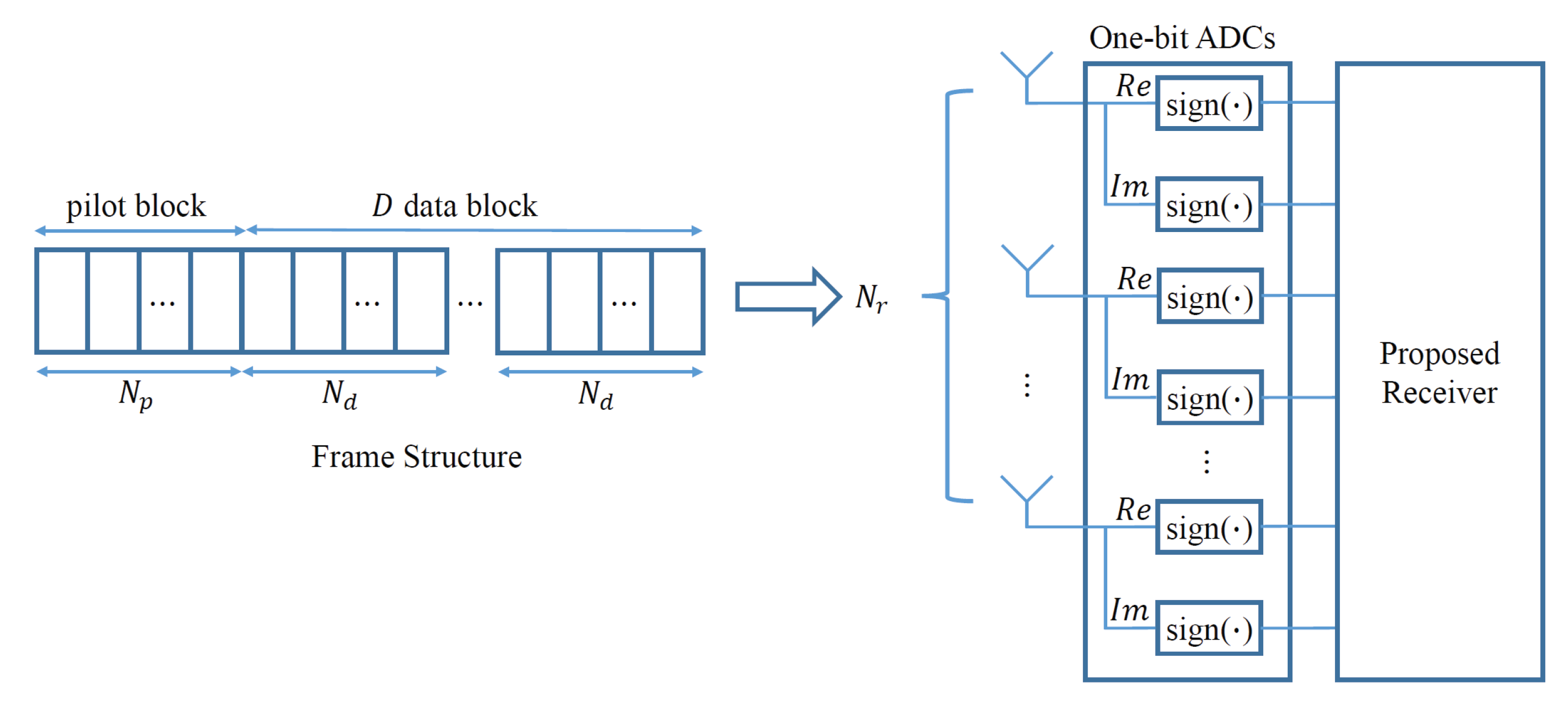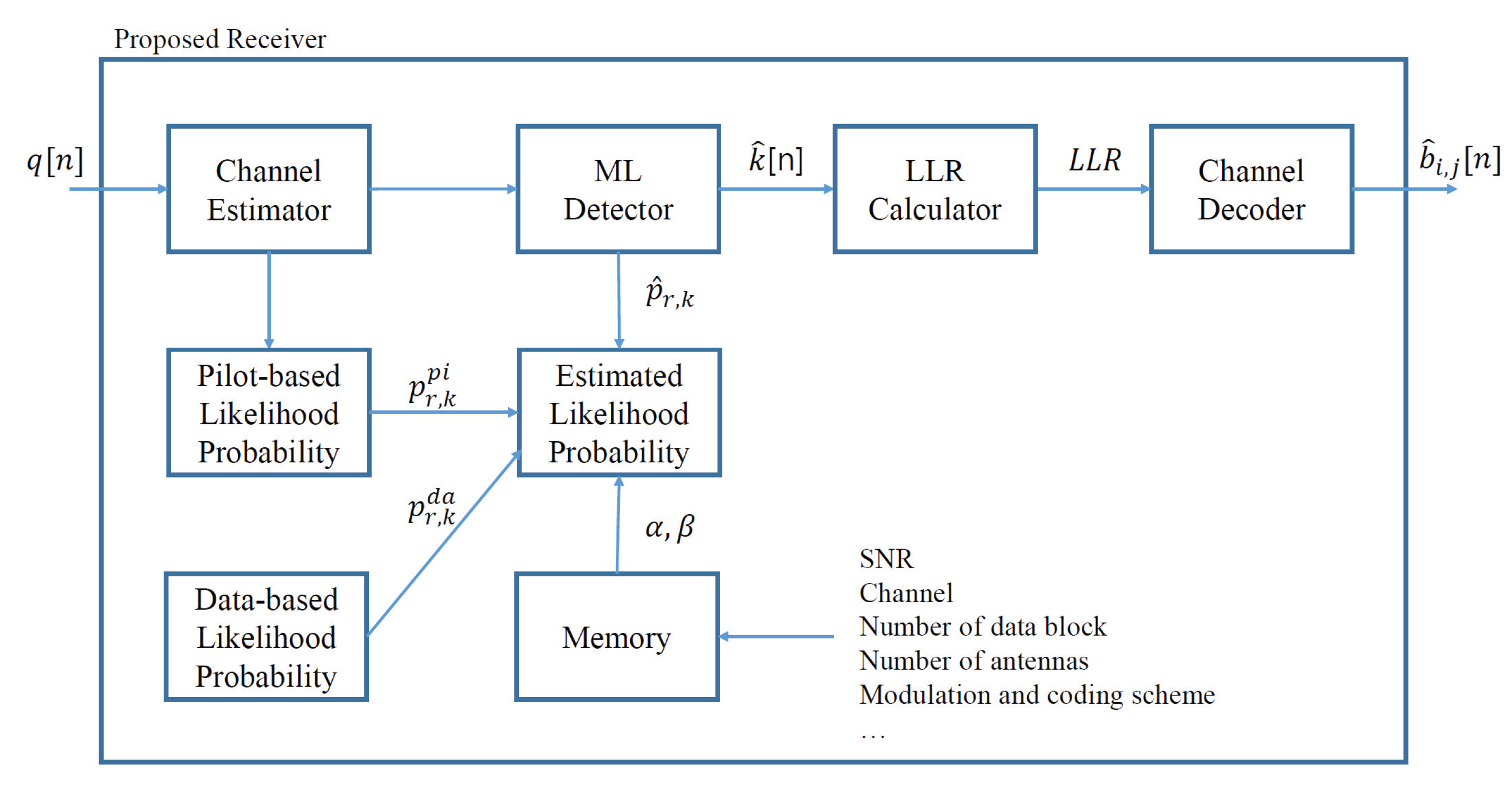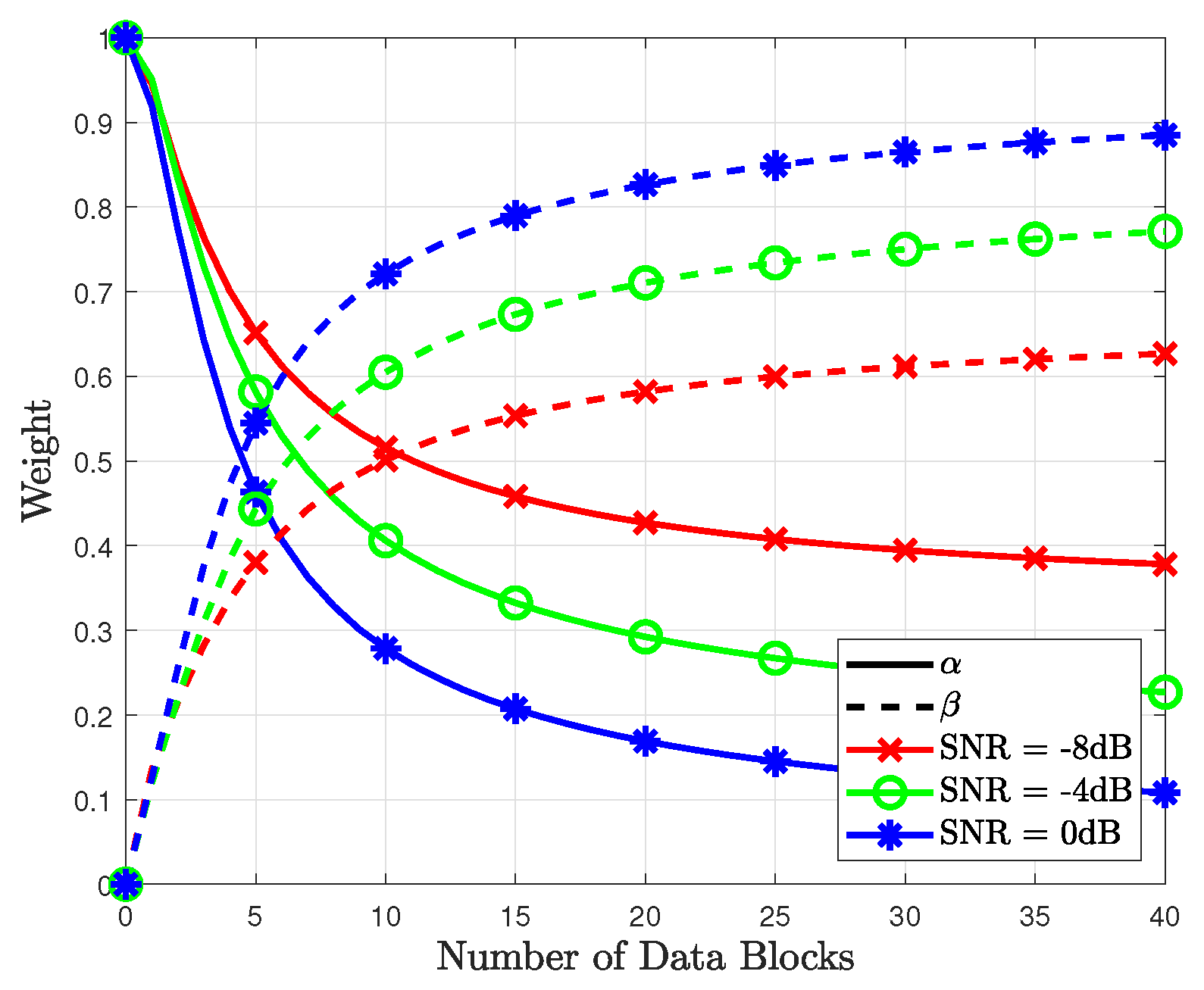Improved Likelihood Probability in MIMO Systems Using One-Bit ADCs
Abstract
1. Introduction
- An optimization problem is formulated to improve the pilot-based likelihood probability. In particular, a data-based likelihood probability is defined using detected data symbols, and a weighted combination method is proposed between the pilot- and data-based likelihood probabilities. The optimization problem minimizes the expected mean squared error (MSE) between the true and weighted combined likelihood probabilities. Unlike the likelihood probability in [32], the data-based likelihood probability considers all detected data symbols in its calculation, and the weights are unconstrained rather than summed up to one.
- A computationally efficient method for solving the optimization problem is proposed. The optimization problem is challenging to solve because the non-linear function in the likelihood probability and the expression of the data-based likelihood probability are mathematically intractable. Hence, the method exploits realized samples to obtain weights for the optimization problem. The expectation of optimization problem is replaced with the average of the realized samples. The solution to the optimization problem is derived using the least-squares method. Because the derived solution is obtained offline, its weights are saved in memory.
- The effectiveness of the proposed method is demonstrated through simulations. The combined weights for the proposed method are updated from the memory at each end of the data block because updating the weights of every data symbol is burdensome to the memory. Based on simulation results, the proposed method indicates improved performance compared with conventional methods without sacrificing complexity. This is because the proposed method improves the reliability of the likelihood probability by exploiting the detected symbols.
2. System Model
3. Optimization Problem
3.1. Data-Based Likelihood Probability
3.2. Problem Definition
4. Proposed Method
4.1. Proposed Method
4.2. Proposed Receiver
| Algorithm 1: Proposed Method |
1 Pilot transmission 2 Compute initial channel estimate 3 Obtain pilot-based likelihood probability , using (8). 4 Set initial estimated likelihood probability , . 5 Data transmission 6 for to D do 7 for to do 8 Detect data symbol based on ML criterion (20). 9 Calculate data-based likelihood probability using (13). 10 Compute LLR based on (21). 11 Obtain decoded data from channel decoder. 12 end 13 Obtain trained weights from memory obtained using (19). 14 Update estimated likelihood probability from (14). 15 end |
5. Simulation Results
- PCSI: As an optimal case, the likelihood probability is obtained based on perfect channel information.
- CE: This is a conventional method in which the likelihood probability is computed based on the channel estimates obtained during the pilot transmission. In this method, the likelihood probability remains unchanged during data transmission.
- Optimal: This method obtains the optimal weights in the optimization problem (15) via exhaustive search, where the resolution of the weights is set to .
- Conv RL: Weights are obtained using the RL method presented in [32]. In this RL method, the sum of the weights is always 1, i.e., . This is expressed aswhere . Unlike the method presented in [32], the Conv RL method obtains the weights via an offline manner. Subsequently, the obtained weights are applied in the weighted combination method expressed in (14).
6. Conclusions
Funding
Institutional Review Board Statement
Informed Consent Statement
Data Availability Statement
Conflicts of Interest
References
- Swindlehurst, A.L.; Ayanoglu, E.; Heydari, P.; Capolino, F. Millimeter-Wave Massive MIMO: The Next Wireless Revolution? IEEE Commun. Mag. 2014, 52, 56–62. [Google Scholar] [CrossRef]
- Heath, R.W.; Gonzalez-Prelicic, N.; Rangan, S.; Roh, W.; Sayeed, A.M. An Overview of Signal Processing Techniques for Millimeter Wave MIMO Systems. IEEE J. Sel. Signal Process. 2016, 10, 436–453. [Google Scholar] [CrossRef]
- Busari, S.A.; Huq, K.M.S.; Mumtaz, S.; Dai, L.; Rodriguez, J. Millimeter-Wave Massive MIMO Communication for Future Wireless Systems: A survey. IEEE Commun. Surveys Tut. 2017, 20, 836–869. [Google Scholar] [CrossRef]
- Wang, X.; Kong, L.; Kong, F.; Qiu, F.; Xia, M.; Arnon, S.; Chen, G.; Rodriguez, J. Millimeter Wave Communication: A Comprehensive Survey. IEEE Commun. Surveys Tut. 2018, 20, 1616–1653. [Google Scholar] [CrossRef]
- Hemadh, I.A.; Satyanarayana, K.; El-Hajjar, M.; Hanzo, L. Millimeter-Wave Communications: Physical Channel Models, Design Considerations, Antenna Constructions, and Link-Budget. IEEE Commun. Surveys Tut. 2018, 20, 870–913. [Google Scholar] [CrossRef]
- Bang, J.; Chung, H.; Hong, J.; Seo, H.; Choi, J.; Kim, S. Millimeter-Wave Communications: Recent Developments and Challenges of Hardware and Beam Management Algorithms. IEEE Commun. Mag. 2021, 59, 86–92. [Google Scholar] [CrossRef]
- Lin, Z.; An, K.; Niu, H.; Hu, Y.; Chatzinotas, S.; Zheng, G.; Wang, J. SLNR-based secure energy efficient beamforming in multibeam satellite systems. IEEE Trans. Aerosp. Electron. Syst. 2023, 59, 2085–2088. [Google Scholar] [CrossRef]
- Walden, R.H. Analog-to-Digital Converter Survey and Analysis. IEEE J. Sel. Areas Commun. 1999, 17, 539–550. [Google Scholar] [CrossRef]
- Murmann, B. ADC Performance Survey 1997–2023. Available online: https://github.com/bmurmann/ADC-survey (accessed on 2 May 2023).
- Zhang, J.; Dai, L.; Li, X.; Liu, Y.; Hanzo, L. On Low-Resolution ADCs in Practical 5G Millimeter-Wave Massive MIMO Systems. IEEE Commun. Mag. 2018, 56, 205–211. [Google Scholar] [CrossRef]
- He, H.; Wen, C.K.; Jin, S. Bayesian Optimal Data Detector for Hybrid mmWave MIMO-OFDM Systems with Low-Resolution ADCs. IEEE J. Sel. Signal Process. 2018, 12, 469–483. [Google Scholar] [CrossRef]
- Cheng, X.; Xia, B.; Xu, K.; Li, S. Bayesian Channel Estimation and Data Detection in Oversampled OFDM Receiver With Low-Resolution ADC. IEEE Trans. Wireless Commun. 2016, 64, 2541–2556. [Google Scholar] [CrossRef]
- Fan, L.; Jin, S.; Wen, C.K.; Zhang, H. Uplink Achievable Rate for Massive MIMO Systems With Low-Resolution ADC. IEEE Commun. Lett. 2015, 19, 2186–2189. [Google Scholar] [CrossRef]
- Roth, K.; Nossek, J.A. Achievable Rate and Energy Efficiency of Hybrid and Digital Beamforming Receivers With Low Resolution ADC. IEEE J. Sel. Areas Commun. 2017, 35, 2056–2068. [Google Scholar] [CrossRef]
- Liang, N.; Zhang, W. Mixed-ADC Massive MIMO. IEEE J. Sel. Areas Commun. 2016, 34, 983–997. [Google Scholar] [CrossRef]
- Saxena, A.K.; Fijalkow, I.; Swindlehurst, A.L. Analysis of One-Bit Quantized Precoding for the Multiuser Massive MIMO Downlink. IEEE Trans. Signal Process. 2017, 65, 4624–4634. [Google Scholar] [CrossRef]
- Khalili, A.; Shiranin, F.; Erkip, E.; Eldar, Y.C. MIMO Networks With One-Bit ADCs: Receiver Design and Communication Strategies. IEEE Trans. Commun. 2021, 70, 1580–1594. [Google Scholar] [CrossRef]
- Choi, J.; Love, D.J.; Brown, D.R.; Boutin, M. Quantized Distributed Reception for MIMO Wireless Systems Using Spatial Multiplexing. IEEE Trans. Signal Process. 2015, 63, 3537–3548. [Google Scholar] [CrossRef]
- Choi, J.; Mo, J.; Heath, R.W. Near Maximum-Likelihood Detector and Channel Estimator for Uplink Multiuser Massive MIMO Systems with One-Bit ADCs. IEEE Trans. Commun. 2016, 64, 2005–2018. [Google Scholar] [CrossRef]
- Jeon, Y.S.; Lee, N.; Hong, S.N.; Heath, R.W. One-Bit Sphere Decoding for Uplink Massive MIMO Systems with One-Bit ADCs. IEEE Trans. Wireless Commun. 2018, 17, 4509–4521. [Google Scholar] [CrossRef]
- Hong, S.N.; Lee, N. Soft-Output Detector for Uplink MU-MIMO Systems with One-Bit ADCs. IEEE Commun. Lett. 2018, 22, 930–933. [Google Scholar] [CrossRef]
- Wang, F.; Fand, J.; Li, H.; Chen, Z.; Li, S. One-Bit Quantization Design and Channel Estimation for Massive MIMO Systems. IEEE Trans. Veh. Tech. 2018, 67, 10921–10934. [Google Scholar] [CrossRef]
- Nguyen, L.V.; Swindlehurt, A.L.; Nguyen, D.H.N. SVM-Based Channel Estimation and Data Detection for One-Bit Massive MIMO Systems. IEEE Trans. Signal Process. 2021, 69, 2086–2099. [Google Scholar]
- Wang, S.; Li, Y.; Wang, J. Multiuser Detection in Massive Spatial Modulation MIMO with Low-Resolution ADCs. IEEE Trans. Wireless Commun. 2015, 14, 2156–2168. [Google Scholar] [CrossRef]
- Mollen, C.; Choi, J.; Larsson, E.G.; Heath, R.W. Uplink Performance of Wideband Massive MIMO with One-Bit ADCs. IEEE Trans. Wireless Commun. 2017, 16, 87–100. [Google Scholar] [CrossRef]
- Li, Y.; Tao, C.; Seco-Granados, G.; Mezghani, A.; Swindlehurst, A.L.; Liu, L. Channel Estimation and Performance Analysis of One-Bit Massive MIMO Systems. IEEE Trans. Signal Process. 2017, 65, 4075–4089. [Google Scholar]
- Mo, J.; Schniter, P.; Gonzalez-Prelcic, N.; Heath, R.W. Channel Estimation in Millimeter Wave MIMO Systems with One-Bit Quantization. In Proceedings of the 48th Asilomar Conference on Signals, Systems and Computers, Pacific Grove, CA, USA, 2–5 November 2014; pp. 957–961. [Google Scholar]
- Wen, C.K.; Wang, C.J.; Jin, S.; Wong, K.K.; Ting, P. Bayes-Optimal Joint Channel-and-Data Estimation for Massive MIMO with Low-Precision ADCs. IEEE Trans. Signal Process. 2016, 64, 2541–2556. [Google Scholar] [CrossRef]
- Jeon, Y.S.; Kim, D.; Hong, S.N.; Lee, N.; Heath, R.W. Artificial Intelligence for Physical-Layer Design of MIMO Communications with One-Bit ADCs. IEEE Commun. Mag. 2022, 60, 76–81. [Google Scholar] [CrossRef]
- Jeon, Y.S.; Hong, S.N.; Lee, N. Supervised-Learning-Aided Communication Framework for MIMO Systems with Low-Resolution ADCs. IEEE Trans. Veh. Tech. 2018, 67, 7299–7313. [Google Scholar]
- Kim, S.; Hong, S.N. A Supervised-Learning Detector for Multihop Distributed Reception Systems. IEEE Trans. Veh. Tech. 2019, 68, 1958–1962. [Google Scholar]
- Jeon, Y.S.; Lee, N.; Poor, H.V. Robust Data Detection for MIMO Systems with One-Bit ADCs: A Reinforcement Learning Approach. IEEE Trans. Wireless Commun. 2020, 19, 1663–1676. [Google Scholar]
- Kim, T.K.; Jeon, Y.S.; Min, M. Low-Complexity MIMO Detection Based on Reinforcement Learning with One-Bit ADCs. IEEE Trans. Veh. Tech. 2021, 70, 9022–9035. [Google Scholar] [CrossRef]
- Choi, J.; Cho, Y.; Evans, B.L.; Gatherer, A. Robust Learning-based ML Detection for Massive MIMO Systems with One-Bit Quantized Signals. In Proceedings of the 2019 IEEE Global Communications Conference (GLOBECOM), Waikoloa, HI, USA, 9–13 December 2019. [Google Scholar]
- Kim, T.K.; Min, M. A Low-Complexity Algorithm for Reinforcement Learning-Based Channel Estimator for MIMO Systems. Sensors 2022, 22, 4379. [Google Scholar] [CrossRef]
- Boyd, S.; Vandenberghe, L. Convex Optimization; Cambridge: Cambridge, UK, 2004. [Google Scholar]








| References | Topics | Key Features |
|---|---|---|
| [1,2,3,4,5,6] | Millimeter-wave system | Mmwave Channel model and implementation |
| [16,17,18,19,20,21] | Low-resolution ADCs | Optimal transceiver design |
| [22,23,24,25,26,27,28] | Channel estimation in one-bit ADCs | Optimal MMSE estimator design |
| [29,30,31,32,33,34,35] | Data detection in one-bit ADCs | Maximum likelihood probability calculation |
| [30,31,32,33] | Machine learning-based data detection | Machine learning-based algorithm |
| Symbols | Descriptions |
|---|---|
| wireless channel matrix | |
| transmitted symbol at time n | |
| candidate transmitted symbol where | |
| detected symbol index at time n | |
| additive white Gaussian noise at time n | |
| received symbol at time n | |
| quantized signal at time n | |
| likelihood probability when symbol is transmitted | |
| true likelihood probability | |
| pilot-based likelihood probability | |
| data-based likelihood probability | |
| estimated likelihood probability |
| Algorithm | Estimated Likelihood Probability Calculation | Total | |
|---|---|---|---|
| Optimal Policy Calculation | Likelihood Probability Update | ||
| RL method [32] | |||
| Proposed method | - | ||
Disclaimer/Publisher’s Note: The statements, opinions and data contained in all publications are solely those of the individual author(s) and contributor(s) and not of MDPI and/or the editor(s). MDPI and/or the editor(s) disclaim responsibility for any injury to people or property resulting from any ideas, methods, instructions or products referred to in the content. |
© 2023 by the author. Licensee MDPI, Basel, Switzerland. This article is an open access article distributed under the terms and conditions of the Creative Commons Attribution (CC BY) license (https://creativecommons.org/licenses/by/4.0/).
Share and Cite
Kim, T.-K. Improved Likelihood Probability in MIMO Systems Using One-Bit ADCs. Sensors 2023, 23, 5542. https://doi.org/10.3390/s23125542
Kim T-K. Improved Likelihood Probability in MIMO Systems Using One-Bit ADCs. Sensors. 2023; 23(12):5542. https://doi.org/10.3390/s23125542
Chicago/Turabian StyleKim, Tae-Kyoung. 2023. "Improved Likelihood Probability in MIMO Systems Using One-Bit ADCs" Sensors 23, no. 12: 5542. https://doi.org/10.3390/s23125542
APA StyleKim, T.-K. (2023). Improved Likelihood Probability in MIMO Systems Using One-Bit ADCs. Sensors, 23(12), 5542. https://doi.org/10.3390/s23125542








